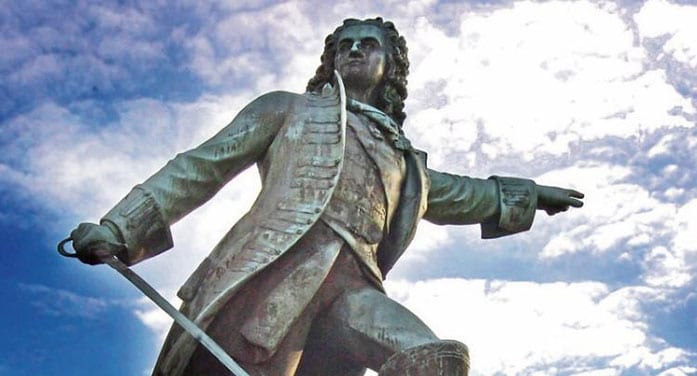
This being the season of St. Patrick’s Day, an Irish-themed column seems appropriate. And a recent news story provides a suitable prompt.
Born between 1655 and 1658, Patrick Sarsfield was a dashing Irish hero. He was brave, patriotic and charismatic. And the fact that he was mortally wounded leading a cavalry charge at the 1693 Battle of Landen – in what is now Belgium – added a suitably tragic touch.
Sarsfield’s current newsworthiness derives from the possibility of discovering and repatriating his remains. While it’s long been assumed that he was interred at the nearby town of Huy, no specific site or marker was known. But now, there’s hope of rectifying that.
The Sarsfields had been in Ireland for almost 500 years. A paternal ancestor – Thomas de Sarsfield – arrived in 1172, accompanying Henry II as part of the early Anglo-Norman invasion. And Sarsfield’s mother came from the old Gaelic aristocracy. The family was thus Catholic, rooted and connected.
However, the young Sarsfield had a problem. As a second son, his inheritance prospects were meagre. So he did one of the obvious things and joined the military.
FROM THE ARCHIVES: St. Patrick’s Day wasn’t always as benign as it is today by Pat Murphy
Although separate kingdoms, England, Scotland and Ireland were all ruled by the House of Stuart and thus had the same king. So Sarsfield joined the Duke of Monmouth’s English regiment, which gave him some battlefield experience fighting the Dutch.
Then, following his nephew’s death in 1683, Sarsfield inherited the family estate in Ireland. He was now a man of property.
The triggering event that ultimately led to Sarsfield becoming an Irish hero occurred in 1688. In what’s referred to as the Glorious Revolution, the Catholic James II was deposed by William of Orange, his Dutch Protestant son-in-law and nephew.
Because I’ve written about this episode on several previous occasions, I won’t revisit the back story now. Instead, let’s focus on Sarsfield and the impact it had on him. (For those who are interested, see The Stuarts, a dynasty brought down by religion.)
Sarsfield supported James and played a leading part at Wincanton – the only military resistance to William’s army on English soil. Then James fled to France and Sarsfield was effectively stranded.
William, however, offered him a role.
A Catholic army loyal to James had been assembled in Ireland and William preferred not to fight it if he didn’t have to. Would Sarsfield go to Ireland on his behalf, act as an intermediary and help work something out?
But Sarsfield was loyal to James and demurred. This rendered him clearly unreliable, so he was allowed to leave England and join James in France.
Then came the real action for which Sarsfield is remembered.
When James arrived in Ireland in March 1689, Sarsfield was one of his accompanying officers. Tapping into the loyal Catholic army already there and supplementing it with French forces, the intention was to use Ireland as a stepping-stone to England.
It didn’t go well. Not by a long stretch.
By the time the war wound down in late 1691, Sarsfield was the de facto commander of James’s forces in Ireland. The mission had failed but Sarsfield’s reputation for personal derring-do and gallantry was assured. Some may have doubted his prudence and judgment, but none questioned his courage.
It was at this point that William made another offer. If Sarsfield would change sides, he’d be granted lands and his soldiers could join William’s army. But Sarsfield again refused, preferring to negotiate an arrangement whereby he and his men departed for France.
Sarsfield presumably expected to join a French invasion of England, thereby restoring James. It never happened. Instead, he became a marshal of France and died at Landen.
Any assessment of Sarsfield should note that his patriotism was materially different from the modern Irish version.
For one thing, he was a royalist, not a republican. He was loyal to the House of Stuart, meaning James and his successors as kings of England, Scotland and Ireland. They were connected.
Sarsfield also had no apparent trouble with the concept of imperialism. After all, he died fighting for Louis XIV of France, who was then Europe’s main expansionary hegemon.
When Sarsfield was a schoolboy hero of mine in 1950s Ireland, these nuances eluded me. They simply weren’t part of the prevailing narrative.
But they don’t diminish him in any way. Quite the contrary. Real people who inhabited their time are more interesting than historical cartoons.
Let’s hope they find his remains.
Troy Media columnist Pat Murphy casts a history buff’s eye at the goings-on in our world. Never cynical – well perhaps a little bit. For interview requests, click here.
The views, opinions and positions expressed by columnists and contributors are the author’s alone. They do not inherently or expressly reflect the views, opinions and/or positions of our publication.

